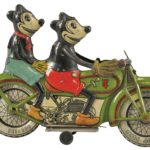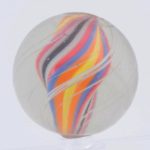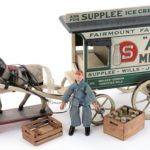by Dick Friz
Dr. Samuel Johnson’s Dictionary, published in 1755, defined “toy” as a “petty commodity, a trifle; a thing of no value, a plaything or bauble.”
Today, the good Doctor must be spinning in his grave. Toys, of almost infinite variety, forever evoke fond, poignant memories of a care-free childhood. Live, in-house antique toy specialty or pop culture auctions have burst forth like a meteor shower and never offered more convenient access for dealers, collectors and museums.
Toys have evolved as one of today’s top five collectibles and, despite rumored sky high prices, they remain one of the most affordable and entertaining collectible pursuits.
There are plenty of ways to keep abreast of this hearty collectible – using the Internet, attending numerous toy specialty shows that run throughout the year, swap meets, flea markets, garage sales, and research of past auction and sales results. As Jason Liebig, a noted cereal box collector, quoted on Eater.com recently said, “In the post-eBay and post-social media world, the importance of face-to-face meet-ups has evaporated, whereas in the past, they were key to building a collection.” Before that time it could take months or years to track down a rare item, but “nowadays, it can be as easy as a simple eBay search and plunking down some cold hard cash.”
Condition, Condition, Condition
For toy buyers, the number one priority is condition. As the late auction owner and toy enthusiast Bill Bertoia always intoned, “A toy’s condition in this field is like location, location, location in real estate.”
This means avoiding the hobby’s dreaded three R’s – replaced parts, restorations, retouching.
In a still relevant Antique Toy World interview from many years ago, Lillian Gottschalk talked about “learning to observe fellow collectors – particularly at major shows and auctions where it’s often crowded and there are many distractions. Note the thoroughness with which they examine every toy they might be intent on purchasing – getting to know (inspect) the toy forward and backwards. I feel the toy with my hands, with my eyes. Then experience takes over.” (A fellow collector suggests smelling the toy or bank. New paint on a retouched figure has a telltale odor unlike the example in its original state.)
In an article by Frank Donegan titled “Banks That Move” in American Magazine some years ago, he had Steven Weiss, now of RSL Auction Company, do the math accessing paint value. “If a bank with 90% of its original paint is worth say $1000, then the one with 95% will sell for $2000, and one with 99% plus may well be worth $5,000.”
Original Boxes
Bob Lesser of NYC, a high-profile spokesman, whose comic and space toy collections have inspired books and exhibitions, consuls, “Try to collect toys in mint condition with their original boxes.” He added, “that by establishing this internal discipline (as you seek out collectible toys), dealers will recognize you as a mint collector and therefore offer you their finest; you’ll be paying more but getting the best of their wares.”
Original boxes, many of which offer powerful visuals, make a toy eminently more displayable and enhances the lot’s value by as much as 25-35%. Wooden boxes for banks are more stark, usually giving only the name of the bank, its manufacturer, and possible patent date, stenciled in black. There have been instances when a bank box sold separately outshines the bank itself in price.
Choices Upon Choices
A full spectrum of toy collector categories beckon – with well over 30 toy subsets that intersect and coalesce. Here’s a brief crash-course on a cross section of the trendsetters. Examples here reflect a wide range of prices for toys at auction over the years:
Mechanical Banks: Considered the aristocrats of the toy realm, these were originally created to promote saving money among children in the mid-19th century. Most observers feel that banks are recession-proof and their popularity and value continues to appreciate unabated, although lower end banks slumped a bit.
In reality, only a handful of bank patrons have the deep pockets to spend anything like the $250,000 Freedman’s Bank brought in at the “tag sale” that dispersed the Perelman Toy Museum in Philadelphia in September, 1988. At that same event, the bank titled Darky With Watermelon fetched $245,000 as did the bank titled Old Woman In the Shoe.
Antique Still Banks: Technically, still banks are considered to be any item that is meant to receive and store coins, but in the world of antiques it means much more than a “penny jar.”
Some good auction examples are from an RSL Auction Company event featuring items mostly from the Andy and Susan Moore Collection:
- Flatiron Building still bank, large size, made by Kenton: $10,500.
- Old South Church, manufacturer unknown, 1895, large size: $44,400.
- Masonic Temple, 1874, Kaiser & Rex: $12,000.
- Circuit Rider Still Bank, probably Ives: $40,750.
- Little Jocko Musical bank, by Strauss. 1910-1920; turning crank twirls monkey: $3,845.
Transportation Toys: Typically created in cast-iron, pressed steel, wood painted and lithographed tin, these were created in every size from miniature to kid-size rideables to give children their own version of the real “adult toys.”
- Original Swivel-Head Patrolman Crash Car Cycle, Hubley ca. 1930s: $4,130.
- “Amerika” Ocean Liner, Marklin, early $1,900, new record at $271,400 at Bertoia’s in May, 2016.
- ‘August Victoria,” Marklin Oceanliner with early 1900s, clockwork, ex-Marklin Museum: $230,000 Auktionhaus Hohenstein, 2015.
- Lockheed monoplane, Vindex salesman’s sample, ca 1929: $12,980.
- Tally Ho Horse Drawn Carriage, ca. late 1890s, cast-iron; ex. Barenholtz scored big at $92,000 at Julia’s in 2005.
Trains & Accessories: The largest of all categories, rail fans number some 300,000 in the U.S. alone. Prior to 1881, toy trains had wheels but no tracks to run on. Later, tracks and sets of toy trains started to be manufactured. The gauge, or width of the track, determines the size of the train, with a standard gauge being 2 1/8î wide until the Depression and World War II, when a smaller gauge of 1 1/4″ was used to be more cost-effective.
- Francis Field & Francis Train Set, ca. 1870s; hand-painted tin locomotive, tender and two coaches pull toy, exceptional detail: $64,900.
- Voltramp 2222 Locomotive ca. 1910, $30,680. Bertoia Auctions, 2014.
- American Flyer Presidential Passenger Set, $8,260. Bertoia Auction, 2016.
Board Games: Typically, early board games featured a battle between two foes, which continues to be a theme today. Block sets, picture and dexterity puzzles, card games, and long-time favorites such as Monopoly, checkers, backgammon, mahjong, and chess, among others, come to mind as games that are collectible yet fluxuate in value over time.
- “Bulls & Bears, The Great Wall St. Game” by McLaughlin, printed in 1883, $30,800 at a 1992 auction. Pook and Pook with Noel Barrett.
- “Game of Man in the Moon” by Mclaughlin, at $6,050 – a real buy compared its value today: twenty-two large-sized parlor board games, primarily Mclaughlin, Parker Brothers, Milton Bradley sold for five figures and more.
- Charles Darrow’s first Monopoly Game handily “passed go” at $131,000, when sold by the (Malcolm) Forbes family at Sotheby’s London, 2011.Comic/Character Toys: Comic character toys, inexplicably, have been in a state of flux for several decades but show signs of a revival with the renewed interest in classic comic characters and vintage memorabilia.
- Alphonse & Gaston Auto, Kenton, ca. 1911, cast-iron: $4,200 at Bertoia Auctions, 2014.
- “Seeing New York” #899 open Bus, Kenton, ca 1910, four comic figures including Yellow Kid, Happy Hooligan etc.: $5,100. Bertoia Auctions, 2014
- Superman Rollover Airplane, Marx, 1940s, boxed Man of Steel toys soar high, $5,015.
- Barney Google Sparkplug Scooter Race, J. Chein. ca. 1928, King Features Syndicate: pull toy: $2,950.
- Aunt Eppie Hogg in Truck, (Ger.) possibly Nifty, Skipper driving (replaced figure); $5,900.
- Dolls, Dollhouses, Accessories, Teddy Bears and other Stuffed Animals: Since early man, dolls have brought joy and created fond memories for so many. Today, this ever-expanding category draws the eye not only of the child, but the sophisticated adult toy collector.
One of the top selling doll houses in auction legend is a ca. 1740-1750 Georgia quoined “stone” van Haeflin House, 49 1/4 inches high. Named for its prior ownership by the Baroness Ann van Haeflin, it peaked at $132,250 at Noel Barrett’s Old Salem Museum Collection sale a few years ago.
Doorstops: Creative, colorful, and useful, these long-standing antiques run the gamut from historically significant to whimsical.
- Girl Holding Hem of Her Skirt, Doorstop, Bradley & Hubbard, on deco base: $3540.
- Pekinese Doorstop, Hubley, Cat. 454 – dogs are popular sellers: $1298.
- Large Footmen Doorstop, Hubley, Fish design No 248, great deco form: $1003. Nichols House Doorknocker, cast-iron, Salem, Mass. Samuel McIntire Home: $1180.
- Holiday Fare: Among all the categories in the toy realm, there is none more fanciful, or created in a wider range of materials than Santa and his fellow holiday keepsakes. Candy containers, jack-in-the-boxes, tree ornaments, lights; Halloween pumpkins, witches and black cats loom large to upstage Santa. Valentines, Easter, Thanksgiving, July 4th, and St. Pats and even Washington’s birthday holiday toys are all much in demand.
- Nodding Santa on Wheeled Platform, (Ger) papier mache and composition, 20 1/2î high: $16,520.
- Santa Driving Wicker Car, (Ger.) composition Santa in cloth rcoat; rabbit fur beard, feather tree: 13 1/2î wide: $4,130.
- Elf At Wine Cask, Dresden, (Ger.) late 1890s, tree ornament, wood, blown glass, leather: $1,298.
- Misc. Tin Character Toys: These are favorites among those who enjoy exploring the bright and colorful printing on tin toys allowing the detail to be in the image on a formed piece of tin.
- Clown With Performing Poodles, Ginthermann (Ger.) clown trainer with three dancing dogs, $4,425.
- Matador With Bull (pictured) F.Martin, (Fr.) ca 1894; clockwork figures chase each other in a circle, $7,080, Bertoia Auctions.
- Admiral Peary on Dog Sled, F. Martin, early 1900s; cotton robed figure of Arctic explorer Peary in sled drawn by four dogs, clockwork, $5,310.
- Snowy Mountain, Castle Lodge wood, composition: $1,888.
- Military Miniatures: Royalty and other world figure manufacturers began with the hollow lead hand-painted soldiers. These have a noble heritage that extends back to the Roman Empire. Its golden era came in the Victorian Age. This category does not just include militaria, but extends to civilian sets, farm and sports sets and others.
- Marine Band in winter dress, ca. 1955, $1,150.
- Wm. Hocker Types of the British Empire #1 Royal Engineers Balloon Section with Box, 5 pieces, $650, Old Toy Soldier Auctions
- Britains Set #25B Japanese Infantry Small b-size in original illustrated box, ca. 1904, $2,600, Old Toy Soldier Auctions
Auction Resources
One of the best resources you can obtain from auction houses are their catalogs. These sell for anywhere from $25 to $40. Many of them often appear in hardbound with lavish full color photographs and concise descriptions including manufacturer, date produced, size and pre-sale estimates. Catalogs are indispensable and moreover, will serve as instant reference when attending future auctions. Along with your catalog, indispensable auction-attending accessories mandate the bidder be equipped with a black light, magnet, loupe. The late Lillian Gottschalk, the doyenne of transportation toy collectors, along with husband Bill, was known to include a dose of smelling salts in her purse.
Dave Bausch, co-founder of the Allentown Toy Show and a collector for over 50 years has this caveat to collectors: “Be patient. All too often someone wants to build a lifetime collection overnight. It can be a very expensive lesson. Learn as much as you can and have fun. That’s what it’s all about.”








Related posts: